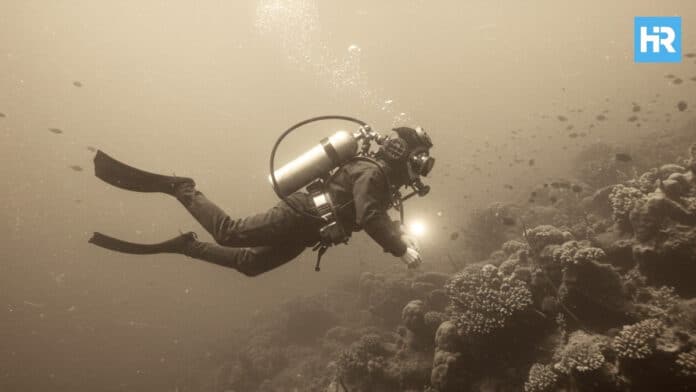Diving has always captured people’s imagination, probably because of how captivating the ocean is.
For thousands of years, humans have been drawn to the ocean, whether it was to gather pearls, sponges, and other treasures or to explore the mysterious world below the surface.
Over time, diving has evolved from a way to survive to something much more—it’s grown with science and technology and turned into a sport people love.
Ancient civilizations devised clever ways to dive deeper and stay underwater longer, which set the stage for the modern equipment we use today.
But of course, the evolution of scuba diving took centuries of experimentation, creativity, and determination to become what it is today.
So, let’s travel back in time to see how diving started, how scuba diving was invented, and how it revolutionized underwater exploration.
- Diving has changed a lot over thousands of years, starting with people holding their breath and growing into modern scuba gear that lets us stay underwater much longer.
- Early tools like diving bells and simple breathing devices helped create the equipment we use today.
- Jacques Cousteau and Emile Gagnan together invented the modern demand regulator used in underwater diving.
The History of Diving
For thousands of years, people have been diving beneath the surface of the water.
What started as holding their breath to gather food or search for lost treasures has evolved into a worldwide activity that lets people explore the underwater world for fun, work, or science.
The history of diving shows how people have always found ways to overcome challenges and reach greater depths.
People dove into the seas in ancient Mesopotamia to find pearls, sponges, and other resources.
They would collect these items by free diving––a type of diving that requires you to only hold your breath.
By around 4400 BC, during the Stone Age, swimming and diving were skills that some tribes had mastered.
In Egypt, rock carvings show swimmers from this time, and ancient jewelry made from deep-sea corals suggests that people were already diving into deeper waters to collect materials.
The Bronze Age, which lasted from around 4500 to 2400 BC, brought more examples of early diving.
Items like mother-of-pearl oysters were found in the ancient city of Ur, which showed that people were already figuring out ways to explore the ocean.
The Sumerians even had a word, “ninri,” which meant “to dive” or “to sink.”
The Epic of Gilgamesh, one of the oldest written stories, references trading rare shells collected through diving.
The Greeks also made significant contributions to early diving.
Homer wrote about sponge divers around 1000 BC. During the Battle of Salamis, a Greek man named Scyllias and his daughter Hydna used their diving skills to cut the moorings of Persian ships during a storm.
And it was these actions that showed how important diving could be in military strategy.
Around the same time, the Assyrians were experimenting with using camel stomachs as air reservoirs, and carvings from that era show swimmers using what might have been early floatation devices.
By 400 BC, Aristotle wrote about divers using a simple device called a diving bell, which trapped air underwater.
This technology was used by Alexander the Great’s army to stay submerged longer.
Centuries later, during the Renaissance, Leonardo da Vinci sketched ideas for diving suits and fins that could help people explore beneath the waves.
In 1535, Guglielmo de Lorena created one of the first usable diving bells, which allowed divers to reach the seafloor and recover items from shipwrecks.
In the 17th century, Edmund Halley, famous for Halley’s Comet, improved the diving bell—his design allowed divers to stay underwater for hours by replenishing the air supply.
This marked a turning point in underwater exploration.
In the 18th century, Freminet, a French inventor, created the “hydrostatic machine,” an early helmet and air system that paved the way for more advanced underwater breathing devices.
By the 19th century, Charles Anthony and John Deane’s invention of air pumps connected to diving helmets made it possible for divers to work underwater for longer periods.
Over time, these innovations built the foundation for the modern diving equipment and techniques we use today.
The Birth of Modern Scuba Diving
Modern scuba diving, as we know it, began with Jacques Cousteau and Emile Gagnan’s invention of the Aqua-Lung in 1943.
This device allowed divers to breathe underwater using compressed air.
Nothing had been seen like this before—it transformed diving from a dangerous activity into something that could be done safely for fun or exploration.
With the invention of the Aqua-Lung, scuba diving became popular worldwide.
By the 1950s, training programs and certifications started to make the activity safer and more accessible.
Agencies like PADI and NAUI began offering training for people who wanted to dive for fun or work.
Today, more than two million people in the U.S. alone are certified divers.
Certification programs are open to anyone in good health, and kids as young as 10 can get a junior certification to dive in shallow waters.
Diving as a Sport
It was in the 19th century when diving became a sport.
In places like Halle, Germany, and Sweden, people performed daring stunts and flips from high platforms.
Germany’s first organized diving club, Neptun, was created in 1840.
By the early 20th century, diving had become a competitive event, and in 1904, it was added to the Olympics in St. Louis.
Over the years, diving competitions evolved, with new rules and scoring systems introduced in 1908.
Coaches like Ernst Brandsten and Fred Cady helped athletes improve their skills, and the invention of more flexible diving boards allowed divers to perform more complicated stunts.
In 2000, synchronized diving—where two divers perform identical moves at the same time—became an Olympic sport.
Technology That Changed Diving
Diving equipment has come a long way over the years.
In the 16th century, diving bells made it possible to explore underwater for longer periods.
By the 19th century, gas cylinders and helmets allowed divers to stay submerged for extended times.
Inventions like buoyancy control devices (BCDs) and dive computers made diving safer and easier in the 20th century.
BCDs, introduced in the 1970s, gave divers better control over their depth, while dive computers combined important information like depth and air pressure into one device.
These advancements, along with improved wetsuits and underwater communication systems, have made diving more enjoyable and accessible for people around the world.
The Future of Diving
The future of diving looks exciting, with new technologies on the horizon.
Pressurized suits could make it possible to explore even deeper parts of the ocean, while advanced decompression systems are being developed to make long dives safer.
Other innovations, like electronic navigation systems and underwater drones, are giving divers new ways to explore the ocean.
As technology continues to improve, the possibilities for underwater adventures are limitless.






